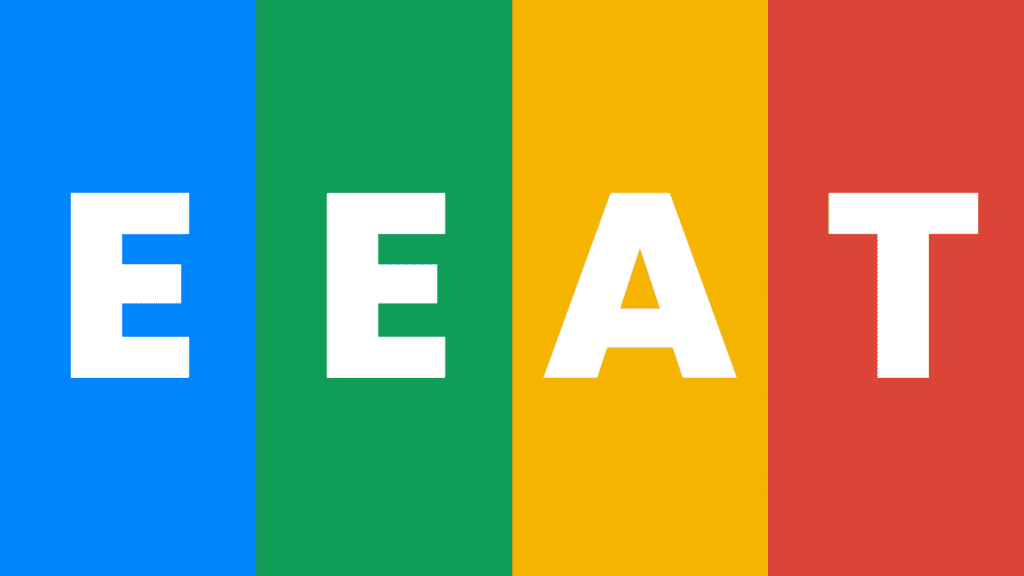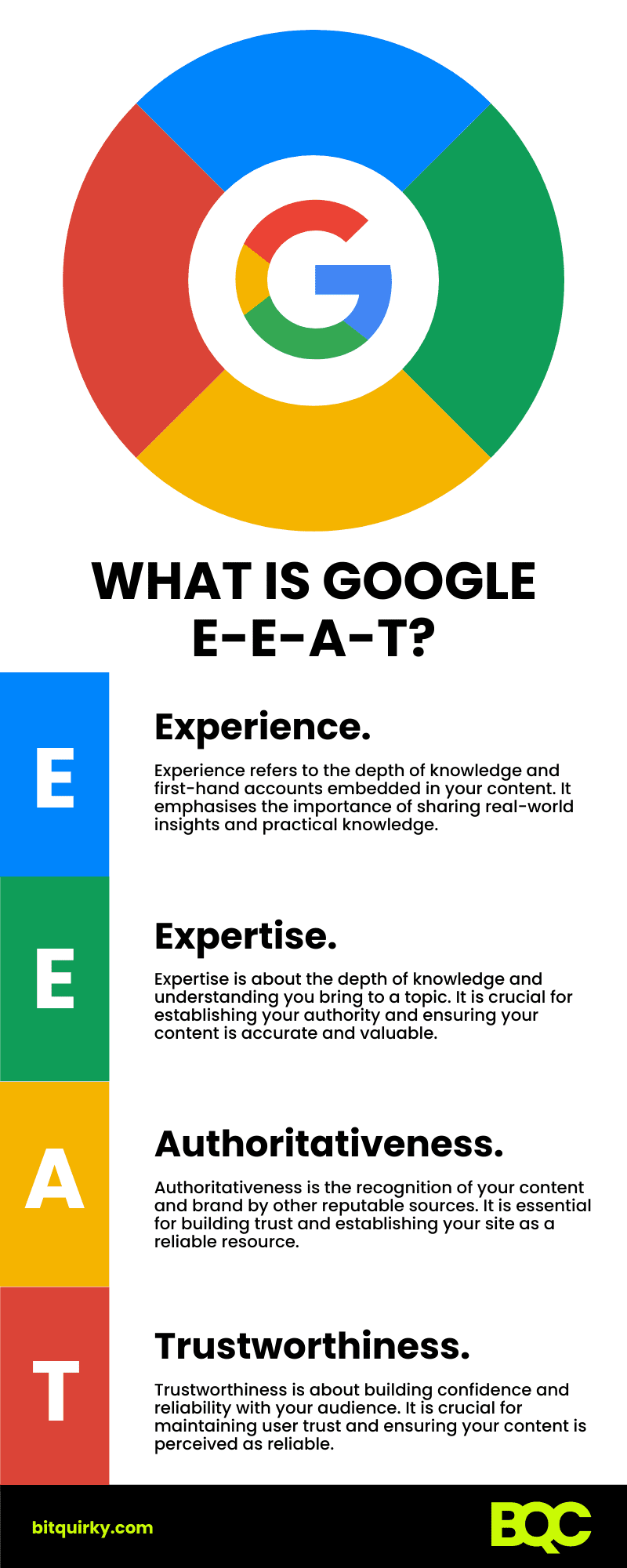Staying ahead of the curve online is essential for any business. Google’s E-E-A-T guidelines—Experience, Expertise, Authoritativeness, and Trustworthiness—have become a cornerstone of SEO and content strategies.
Understanding and implementing these principles will significantly impact your site’s visibility and credibility, ultimately improving your SEO performance.
This guide will delve deep into each element of Google E-E-A-T and provide actionable insights to help you optimise your content and boost your SEO efforts to boost your SEO with Expertise, Experience, Authority, and Trustworthiness.
What is Google E-E-A-T?
Google E-E-A-T stands for Experience, Expertise, Authoritativeness, and Trustworthiness. Google’s algorithm and quality raters use these criteria to assess the quality of content and determine its ranking in search results.
History and Evolution of E-E-A-T
Initially introduced as E-A-T, Google added “Experience” to the mix in 2022 to emphasise the importance of first-hand knowledge and real-world experience in content creation. This addition highlights the need for content demonstrating expertise and sharing genuine, practical insights.
Breaking Down E-E-A-T
To truly harness the power of Google’s E-E-A-T guidelines, it’s crucial to understand each component in detail. E-E-A-T stands for Experience, Expertise, Authoritativeness, and Trustworthiness. These elements form the foundation of high-quality content that appeals to users and ranks well in search engine results. By dissecting each aspect, we can uncover how they contribute to a robust content strategy that enhances SEO performance.
Experience
Definition and Importance
Experience refers to the depth of knowledge and first-hand accounts embedded in your content. It emphasises the importance of sharing real-world insights and practical knowledge.
How to Showcase Experience in Your Content
- Case Studies: Include detailed case studies that outline specific challenges, actions taken, and results achieved.
- Personal Stories: Use first-person narratives to recount real experiences, adding authenticity to your content.
- Practical Applications: Highlight your strategies’ practical applications and results to demonstrate effectiveness.
Examples of Effective Experience Content
A blog post on digital marketing strategies might include a case study of a successful campaign detailing the challenges faced, actions taken, and results achieved. This provides tangible proof of experience and builds credibility.
Expertise
Definition and Importance
Expertise is about the depth of knowledge and understanding you bring to a topic. It is crucial for establishing your authority and ensuring your content is accurate and valuable.
Strategies to Showcase Expertise
- Credentials and Certifications: Highlight your credentials, certifications, and industry recognitions to establish authority.
- Detailed and Accurate Content: Provide well-researched content with accurate information that adds value to the reader.
- Regular Updates: Keep your content updated with the latest trends and insights to maintain its relevance.
Examples of Expert Content
A whitepaper on SEO best practices authored by a certified SEO specialist, including in-depth analysis and data-driven insights, is an excellent example of expert content. It demonstrates a high level of knowledge and authority on the subject.
Authoritativeness
Definition and Importance
Authoritativeness is the recognition of your content and brand by other reputable sources. It is essential for building trust and establishing your site as a reliable resource.
Building Authority Through Content
- High-Quality Backlinks: Earn from reputable websites to enhance your content’s credibility.
- Citations and Endorsements: Get cited by industry leaders and authoritative publications to build recognition.
- Engagement with Influencers: Collaborate with influencers and thought leaders in your niche to boost your authority.
Examples of Authoritative Content
Having your content cited by a well-known industry blog or being interviewed by a prominent figure in your field can significantly enhance your authoritativeness. This recognition from authoritative sources helps build trust and credibility.
Trustworthiness
Definition and Importance
Trustworthiness is about building confidence and reliability with your audience. It is crucial for maintaining user trust and ensuring your content is perceived as reliable.
Enhancing Trust in Your Content
- Transparent Author Bios: Provide detailed author bios with qualifications and experience to build trust.
- Fact-Checking and Sources: Ensure your content is fact-checked and sources are cited.
- User Reviews and Testimonials: Encourage and display user reviews and testimonials to build credibility.
Examples of Trustworthy Content
A trustworthy website often features detailed author bios, clear contact information, and accurate and reliable content history. This transparency helps build trust with your audience.
Search Engine Journal highlights the critical role of trust in the Google E-E-A-T framework. They state, “Trust is the most critical component of E-E-A-T because untrustworthy pages have low E-E-A-T no matter how experienced, expert, or authoritative they may seem” (Search Engine Journal).
How to Optimise Your Content Strategy for E-E-A-T
Integrating Google’s E-E-A-T guidelines into your content strategy is essential for achieving high search rankings and establishing credibility.
These actionable steps can enhance your content through the lens of Experience, Expertise, Authoritativeness, and Trustworthiness. By focusing on both on-page and off-page optimisation techniques, you can create a comprehensive strategy that appeals to search engines and delivers value to your audience.
Content Creation
Research and Planning
Creating high-quality content that adheres to Google E-E-A-T principles requires thorough research and planning. Identify topics that resonate with your audience and offer unique insights.
Content Types for E-E-A-T
Use a mix of content types, such as blogs, videos, and infographics, to engage your audience and demonstrate your expertise and experience. Different formats can cater to diverse audience preferences and enhance the overall impact of your content.
On-Page Optimisation
SEO Best Practices
Align foundational on-page SEO practices with E-E-A-T principles by optimising meta tags, headings, and content structure. Ensure your website is technically sound, with fast loading times and a mobile-friendly design.
Technical SEO Aspects
Technical SEO involves optimising your website’s infrastructure to facilitate search engines’ crawling and indexing process. This aspect of SEO focuses on enhancing your site’s technical foundation, ensuring that search engines can efficiently understand and rank it.
Unlike content and promotional SEO efforts, technical SEO emphasises improving site speed, mobile optimisation, and secure connections. It plays a vital role in maintaining your website’s overall health by making it accessible and understandable to search engines.
Neglecting technical SEO can result in even the most valuable content being overlooked by search engines, leading to lower rankings and reduced organic traffic. Therefore, it’s essential to prioritise these technical aspects to ensure your content reaches its intended audience.
Off-Page Optimisation
Building High-Quality Backlinks
Building high-quality backlinks is crucial for establishing authoritativeness. Engage in guest blogging, collaborate with industry influencers, and participate in forums and discussions.
Social Proof and Reviews
The role of social proof and online reviews in establishing trust and authority cannot be overstated. Encourage positive reviews and testimonials to enhance your site’s trustworthiness.
Importance of E-E-A-T in SEO
To enhance the visibility and comprehension of your content by search engines, you can implement specific strategies known collectively as “search engine optimisation” (SEO). Google’s SEO guide outlines essential best practices for this purpose. SEO proves particularly effective when applied to content that prioritises users’ needs and interests over search engines.
E-E-A-T is critical for SEO because it helps Google determine the reliability and value of your content. High E-E-A-T scores can lead to better rankings, increased traffic, and enhanced user trust, vital for successful digital marketing.
While E-E-A-T isn’t a specific ranking factor, using a mix of factors to identify content with good E-E-A-T is useful. For example, our systems give even more weight to content that aligns with strong E-E-A-T for topics that could significantly impact the health, financial stability, or safety of people or the welfare or well-being of society. We call these “Your Money or Your Life” topics, or YMYL for short. Google Search Central
Monitoring and Improving E-E-A-T
Tools and Metrics for E-E-A-T
Use tools like Google Analytics, SEMrush, and Moz to monitor your Google E-E-A-T performance. Track metrics such as bounce rate, time on page, and backlink quality to assess your content’s effectiveness.
Continuous Improvement Strategies
Regularly audit and update your content to ensure it remains relevant and accurate. Continuous improvement is key to maintaining high E-E-A-T scores and staying ahead in the competitive digital landscape.
Step-by-Step Google E-E-A-T Implementation Guide
Implementing Google E-E-A-T principles into your content strategy can seem daunting, but breaking it down into manageable steps can make the process more approachable.
This guide provides a clear, actionable roadmap to help you enhance your website’s Experience, Expertise, Authoritativeness, and Trustworthiness. By following these steps, you can create content that ranks well and builds a strong, credible online presence.
To effectively implement Google E-E-A-T principles into your content strategy, follow these steps:
- Conduct a Content Audit:
- Review your existing content to identify gaps in experience, expertise, authority, and trustworthiness.
- Update or remove outdated or low-quality content that does not meet E-E-A-T standards.
- Showcase Experience:
- Incorporate real-life examples, case studies, and personal anecdotes in your content.
- Use first-person narratives to enhance authenticity and provide practical insights.
- Highlight Expertise:
- Ensure that content is created or reviewed by subject matter experts.
- Display author credentials and certifications prominently.
- Use detailed, well-researched content supported by credible sources.
- Build Authoritativeness:
- Earn high-quality backlinks from reputable websites in your industry.
- Get cited by industry leaders and authoritative publications.
- Engage in guest blogging and collaborations with thought leaders.
- Enhance Trustworthiness:
- Be transparent about your content creators by providing detailed author bios.
- Ensure your website is secure (e.g., using HTTPS) and user-friendly.
- Encourage and display user reviews and testimonials prominently.
- Optimise Technical SEO:
- Improve site speed, mobile-friendliness, and site architecture.
- Use schema markup to help search engines understand your content better.
- Regularly Update Content:
- Keep your content current by regularly reviewing and updating it to reflect new information and trends.
- Perform periodic content audits to ensure all pages meet E-E-A-T standards.
Google E-E-A-T FAQs
Is E-E-A-T a direct ranking factor?
How can I demonstrate E-E-A-T on my website?
What are Google's Quality Rater Guidelines?
What role do author bios play in demonstrating E-E-A-T?
How often should I update my content to maintain high E-E-A-T standards?
Wrapped: The Ultimate Guide to Google E-E-A-T
Integrating Google E-E-A-T principles into your content strategy is not just a trend; improving your site’s SEO strategy and building a trustworthy online presence is necessary. By focusing on Experience, Expertise, Authoritativeness, and Trustworthiness, you create content that not only resonates with your audience but also satisfies the rigorous standards set by search engines.
Our Key Takeaways:
- Evaluate and Enhance Your Content:
- Conduct a thorough audit of your existing content. Identify areas where you can incorporate more first-hand experiences, expert insights, authoritative references, and elements that build trust.
- Update your content regularly to reflect the latest information and industry developments, ensuring it remains relevant and valuable to your audience.
- Showcase Real-World Experience:
- Integrate case studies, personal stories, and practical examples into your content to demonstrate your experience and expertise. Use first-person narratives to add authenticity and build a connection with your audience.
- Highlight successful projects and real-world applications of your strategies to showcase your hands-on experience.
- Build and Highlight Expertise:
- Ensure that your content is crafted by or reviewed by experts in the field. Display their credentials and qualifications to establish credibility.
- Develop comprehensive, well-researched content that provides in-depth insights and actionable advice. Consider creating long-form content such as whitepapers, e-books, and detailed guides.
- Establish Authoritativeness:
- Focus on earning high-quality backlinks from reputable websites. Engage in guest blogging, collaborate with industry influencers, and seek citations from authoritative sources.
- Actively participate in industry forums, webinars, and conferences to build your reputation as a thought leader. Share your insights and knowledge to gain recognition and credibility.
- Enhance Trustworthiness:
- Be transparent with your audience. Provide detailed author bios, clear contact information, and transparent disclosure of sources and affiliations.
- Encourage and prominently display user reviews and testimonials. Respond to feedback and engage with your audience to build trust and loyalty.
- Implement robust security measures like HTTPS to ensure your website is secure and trustworthy.
- Optimise Your Technical SEO:
- Ensure your website is technically sound with fast loading times, mobile optimisation, and a clean site architecture. Use schema markup to help search engines better understand your content.
- Monitor your website’s technical health regularly using tools like Google Search Console and promptly address any issues that may arise.
- Continuous Improvement and Monitoring:
- Use analytics tools to monitor your content’s performance and identify areas for improvement—track metrics such as bounce rate, time on page, and backlink quality.
- Conduct regular content audits and updates to maintain high Google E-E-A-T standards. Stay informed about the latest SEO trends and algorithm updates to adapt your strategy accordingly.
By embedding these principles into your content strategy, you can ensure that your site ranks well in search engine results and provides genuine value to your audience. Start by assessing your current approach, making the necessary adjustments, and committing to ongoing optimisations and improvement.
This dedication to Google E-E-A-T will enhance your SEO performance and build a stronger, more trustworthy brand.








